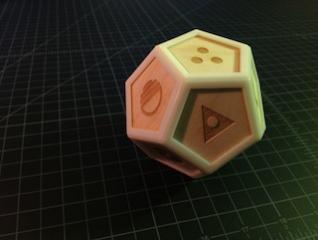The dod is a baseball-sized dodecahedron and wireless controller for the Philips Hue Light System. Its' 12 different orientations control an array of preset light configurations: the user simply positions the dod on a specific facet to tailor their interior lighting, rather than mess with the standard, cumbersome, app-based approach.
Background
Experiments with the Hue API and i2c Accelerometer Communication with the Electric Imp. 3D modeling and rapidly prototyping multiple stages of the physical device. Playing with its' narrative. The Dod's existence stems from my own desires.
Audience
Hue Owners & Wizards
User Scenario
Wizard wakes up. Orients the Dod. A facet resembling a simplified sun is now the top-most face, and the room grows radiant. Later, Wizard wants to read and chill, so wizard re-orients the Dod. A facet resembling a hot mug is now facing up. The lights instantly settle into a subtle warm glow. Wizard feels wizardly.
Implementation
3 Part Cast Plastic Shell, with Lasercut Wooden Inserts. One large screw holds a center mount for The electronics - an accelerometer, Electric Imp, LiOn Battery and usb charger. Also, I have a configured philips hue system it communicates with.
Behind me I have a computer with dod.io all set to go - explaining the process, and illuminating the project's attitude.
Conclusion
I broke a couple of my 3d printed prototypes. I broke a lot of squirrel code before I learnt about bit-shifting to communicate between i2c devices, and about i2c in general. I learnt about the new SLA printer at AMS, about eagle, and fabbing my own circuit boards. I learnt about working around Philips' API, to allow a 3rd Party Device the ability to communicate to my local network.
Background
Experiments with the Hue API and i2c Accelerometer Communication with the Electric Imp. 3D modeling and rapidly prototyping multiple stages of the physical device. Playing with its' narrative. The Dod's existence stems from my own desires.
Audience
Hue Owners & Wizards
User Scenario
Wizard wakes up. Orients the Dod. A facet resembling a simplified sun is now the top-most face, and the room grows radiant. Later, Wizard wants to read and chill, so wizard re-orients the Dod. A facet resembling a hot mug is now facing up. The lights instantly settle into a subtle warm glow. Wizard feels wizardly.
Implementation
3 Part Cast Plastic Shell, with Lasercut Wooden Inserts. One large screw holds a center mount for The electronics - an accelerometer, Electric Imp, LiOn Battery and usb charger. Also, I have a configured philips hue system it communicates with.
Behind me I have a computer with dod.io all set to go - explaining the process, and illuminating the project's attitude.
Conclusion
I broke a couple of my 3d printed prototypes. I broke a lot of squirrel code before I learnt about bit-shifting to communicate between i2c devices, and about i2c in general. I learnt about the new SLA printer at AMS, about eagle, and fabbing my own circuit boards. I learnt about working around Philips' API, to allow a 3rd Party Device the ability to communicate to my local network.


